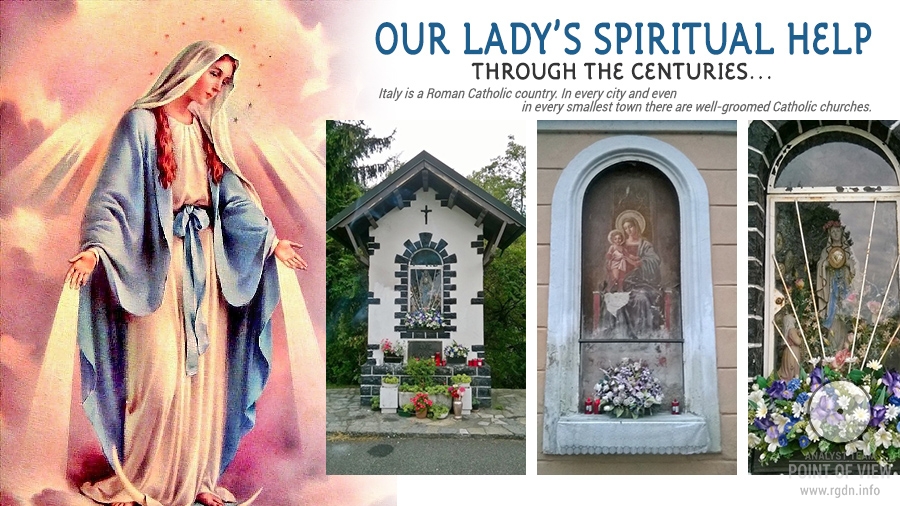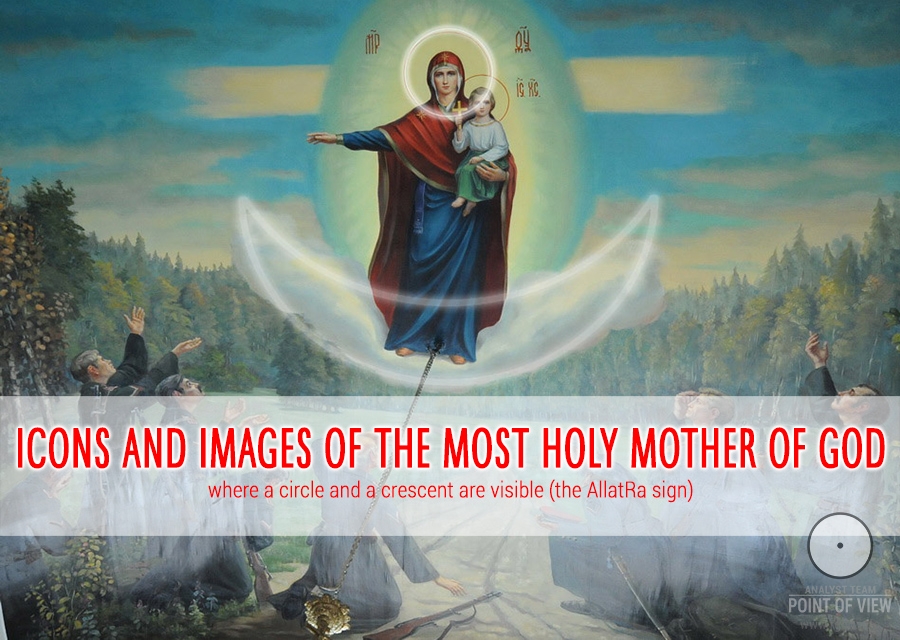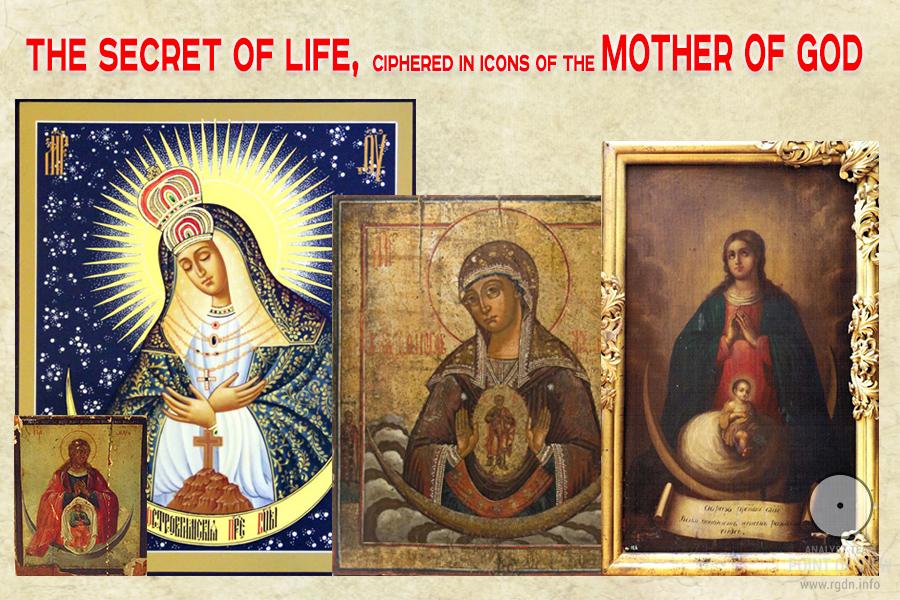Having equipped ourselves with a camera, my friends and I went to explore local cultural heritage sites. Luckily, Barcelona as one of the centres of Templar activities in the Middle Ages is full of architectural riches, so we had an opportunity with our own eyes to see signs and symbols that we had previously seen mostly in books.
However, what we saw there surpassed all our expectations. Local signs and symbols carefully and accurately placed by Knowledgeable people centuries ago still wait for an attentive eye to notice them. Like guiding stars, they are ready to show the road to those who can orient themselves by them. The AllatRa book became an indispensable compass for us in such doing.

Not many people know Virgin Mary has a number of sites in Italy – the very country where everything started and everything will end. It started from Peter and will end with Peter as well. As a matter of fact, the entire history of Catholicism has represented a struggle against the pure and Holy Personality, the mistress, Beloved Disciple and Apostle of Jesus – Mary Magdalene. It’s been a fight for power based on envy and hatred, for She always came to ordinary people, not to religious ministers.
Places of power chosen and attended by Mary are all around Italy. Since local inhabitants lack genuine knowledge, they believe it was Jesus’ mother who came. However, such misunderstanding does not prevent them from receiving help for already several centuries. Nowadays people here have nobody but Mary to rely and set hopes on, because Catholicism as religion can give nothing to a human being.

Italy is a Roman Catholic country. In every city and even in every smallest town there are well-groomed Catholic churches. Many Italians regularly attend Sunday masses, accustoming younger generations to such tradition as well. In schools and kindergartens kids have weekly classes on religion. The church closely interacts with parishioners and their families. Joint family dinners are arranged, where people meet and communicate in an amicable environment.
Virgin Mary is particularly worshipped in this land. Chapels with Her statues are placed in many ordinary yards of dwelling houses, kindergartens and schools, as well as at street crossings. Inside nearly every house there is Her image or figurine.

Many of you certainly attend churches, temples or houses of prayer, and believe in Single God. For sure, many of you respectfully treat the great woman depicted on numerous icons and images, revered in various religions and denominations, and named Mary. Unfortunately, today we know almost nothing about who this woman was and what was her destiny; and hardly many people have an idea of the true essence and meaning of her superior spiritual feat.
We have already dedicated a number of articles and analytical publications to her in the Holy Mother of God (Virgin Mary) section, and today we would like to post a new series of photos clearly showing that in Christian images and icons of Virgin Mary the sign consisting of a circle and a crescent is widely present – the sign that is already familiar to many readers as the AllatRa sign (more details about it may be found in our relevant analytical material).

The star has risen. I see its light even through leaden puffs of low-level clouds. The evening star signifying the coming of the great triumph... The Protecting Veil of the Most Holy Mother of God... Such tenderness, such boundless joy is ringing in the air... Breath helplessly fades, being unable to utter even a slightest word of admiration for your purest beauty, Our Lady… Wonderment in silence…
Having “accidentally” discovered an online collection of images of archaeological artefacts (statuettes and sculptures) devoted to female deities – Mothers of the World, we experienced another culture shock. Based on the primary source it can be concluded the materials were collected by Kulturologia.ru project to whom we express our sincere gratitude. They have brought together an enormous number of facts confirming that in all times, starting from deep antiquity and almost until today, famous and honoured women and female images (also called goddesses) were depicted in various cultures, civilizations and ages, in particular erected of stone, wood or plaster, in frescoes, paintings or bas-reliefs.

Despite the fact that the Christan holy scripture – the Bible (New Testament) contains very few records of Virgin Mary’s words and deeds, her marvellous image and particular respect for her are found all over the world, to this day with inexplicable power attracting believers and atheists in different parts of the globe. We are returning to this wonderful luminous topic again, since we consider it to be one of the most worthy subjects to address and pay attention to. It deserves attention of all people for them to expand their limited understanding of the essence of hidden processes in the universe. Though many people are so far engrossed in earthly and transient things and fail the accept what they don’t physically see, though talks about spirituality and deep inner feelings provoke distrust and detachment, any opinion, even the most deep-rooted one, may be changed, while extinct interest may be inflamed with interesting and obvious facts, for facts are stubborn things.
This article lay idle for a month and a half in my desk. The composition of it involved numerous obstacles, and even after the final article version was prepared and thoroughly edited on the website in the offline mode, the text suddenly and enigmatically disappeared, so that I had to rewrite everything all over again. Nonetheless, after a while I decided to go back to this story for a reason unknown to me.
In my previous publication entitled Grace of the Most Holy Mother of God I disclosed some details of my biography associated with my past spiritual awakening, if such pathos expression would be appropriate for an ordinary non-pathos life situation. In my case I could stop on that, since I am neither a select nor awarded with any particular divine marks or signs. However, something probably clicked inside, and the memory suddenly exposed a very interesting and long-forgotten story from the same time period, which story’s directly connected with Virgin Mary or rather her manifestation during my ordeals of those days. I gave myself a while to mull over whether I should present the story to a wide audience, and if so, in which form should I do that. I was and am still harried by certain contradictions: firstly I wouldn’t like to seem immodest, and secondly I fear to dilute the emphasis, since for better understanding it’s necessary to give details of my life situation in the first part of the story, while that situation had nothing to do with spirituality. Moreover, the whole story looks rather improbable today even for me, and I’m simply astounded what a fine fellow I was in those years.
Nowadays, Kiev Pechersk Lavra is a famous male monastery. Yet, not many people are aware of the historical fact that the Kiev Pechersk cloister initially accommodated both a nunnery and a monastery, representing a unique combination of female and male monastic communities and an abode for all people who endeavoured to learn their inner spiritual world, regardless of their nationality, age or sex. The nunnery (maiden convent), further referred to as the Ascension Convent, was an integral part of the Pechersk monastery complex and occupied one of central locations on the “holy mountain” – the place indicated by the Mother of God to Elder Antony.

Iconography is an art that keeps many secrets. Such secrets are ciphered in signs and symbols which conceal information, concepts and details unapparent for a cursory glance of an average person, but reveal a deep sacral meaning to an inquisitive heart of the one who seeks more than the entire material world can offer to its two-legged batteries. Probably, there is no person on the earth (other than representatives of tribes living in jungles) who hasn’t seen an icon of the Mother of God at least once, namely an icon where there is an up-horned crescent in the lower part of the image or a veil held in Virgin Mary’s hands while her elbows are bent. Icons drawn in such a style have always been particularly nice and attractive for me. Grace and tenderness beyond expression are coming from such images which, like a light amidst impenetrable darkness, are capable of rescuing anyone who asks for Virgin Mary’s help from the quagmire of existence in the brutal world created by people themselves.
I remember my first visit to the church about fifteen years ago. Someone said there was a monastery in Pechersk district of Kiev, where a wonderworking icon of the Mother of God was kept, and, supposedly, if one came there early in the morning, stood at the entire first acathistus and prayed, he or she could ask for certain things, and everything would come true. Yes, this was exactly how I memorized it fifteen years ago: “ask, and everything will come true”. A bait of miracle and wishes fulfilment in those rather troubled times. And I certainly went there, not so much for the sake of asking, but rather to see the icon which was so miraculous to fulfil all people’s wishes. Was it really wonderworking? Just to mention, I was not gullible at all, quite the contrary, but for some reason the mysterious wonderworking icon and the nationwide worship of the Mother of God – the authority – became convincing for me.
As legend says, the initial miracle-working image of the Mother of God with seven arrows was drawn in remote antiquity. According to 19th century publications, this icon is over five hundred years old. In pre-revolutionary Russia there was a famous and respected copy of the icon, which was identified with its legendary original. However, particularities of the image iconography and the fact that the said copy was made on a canvas glued to a wooden board indicate its late origin. The copy was made in the 18th century, probably from the initial icon that had not been preserved and dated back to the 17th century, i.e. the time when many elements of Western iconography emerged in Russian painting. The wonderworking icon of the Mother of God “Seven Arrows” comes from northern Russia. Before the revolution it was kept in the Church of John the Divine on the bank of ToshnyaRiver, not far from Vologda. The legend about the icon resembles similar stories about Mother’s of God images seen in visions by different people. A peasant from Kadnikovsky uyezd (district) suffered from lameness for many years and had no hope already to get cured. Once he was sleeping, and a Divine voice ordered him to find an icon of the Mother of God in the Church of John the Divine bell tower where old icons were kept, and to pray in front of the icon with faith for his disease cure. Having come to that church, the peasant could not do right away what he’d been ordered in the vision. Only after his third request clergymen who did not trust his words let him enter the bell tower and go upstairs. It turned out the icon, being covered with dust and dirt, served as a simple wooden stair on which bell ringers stepped while going up or down the tower. Being terrified with their unintentional sacrilege, clergymen cleaned the icon and held a service in front of it, whereupon the peasant totally recovered. Several years later, the memory of the miracle started gradually fading away and could vanish totally, if it were not for a new God’s affair when the miraculous power of the Mother’s of God icon manifested itself again. In 1830, a horrible cholera epidemic overtook a major part of European Russia, including Vologda province. During the pestilence many sacred items were brought to Vologda from Toshnya, including the icon of the Mother of God with seven arrows, and placed in the “cold” (summer) Church of Dmitry Prilutsky on Navolok, in Vologda Zarechye, to the right of the main city bridge. Christ-loving inhabitants of Vologda held a religious procession with the Seven Arrows icon around the city. After the universal prayer in front of the wonderworking image, cholera abated just as suddenly as it had come.

Project Aim









